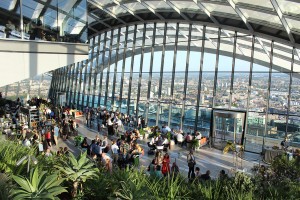 Last night the LexisNexis PSL Property team and their guests enjoyed a unique evening at the 20 Fenchurch Street Sky Garden (view photos here).
Last night the LexisNexis PSL Property team and their guests enjoyed a unique evening at the 20 Fenchurch Street Sky Garden (view photos here).
Located at the top of the ‘Walkie Talkie’, the Sky Garden is a feat of architecture and engineering created - primarily at least - in order to comply with a condition attached to the building’s planning permission pursuant to s.106 of the Town & Country Planning Act 1990.
This got me thinking more broadly about the availability - and visibility - of public spaces in new developments. I recently discovered one such space at Concert Hall Approach, in the South Bank area. I say ‘discovered’ since - hidden behind foreboding metal railings - it looks like private property.
Walk around the South Bank at lunchtime and you’ll find throngs of visitors eating “on the hoof” or - if they are lucky - perched on a traffic bollard. Stroll a little way down Belvedere Road, however, and you’ll find a small, unlocked gate. On this gate, is a sign announcing that the tranquil manicured lawns and gushing water fountain beyond are, in fact, open to the public. Again, we have section 106 to thank for that and I have often used the gardens to picnic under the envious gaze of passers-by.
Emboldened by this discovery, I set out to find more gardens which have been provided by developers and landowners but are unlikely ever to be used to their full potential because they are (deliberately or otherwise) hidden in plain sight.
“Your search returned zero results”
Searching Google brought up very little in terms of a London-wide plan. On reflection, this is somewhat surprising. Where planning authorities have gone to the effort of securing a place for public enjoyment and utility, why not facilitate such use by broadcasting it?
“X” marks the spot…
Faced with this apparent dearth of information, some colleagues and I discussed the possibility of putting together a plan of our own.
The interactive map below plots out the location of the nine “private but public” gardens we know of. (Know of another? Leave us a comment!).
A London-wide plan: a job for the GLA?
What is ultimately needed is a London-wide plan - easily discoverable on the internet and on the ground - identifying all green spaces open to the public. The correct driver for such an initiative would arguably fall under the GLA’s All London Green policy framework (the ‘ALGG’).
The ALGG is intended to promote the design and delivery of ‘green infrastructure’ across London and is comprised of:
- the London Plan policies on green infrastructure and urban greening - and those relating to open spaces, biodiversity, trees & woodland, and river corridors;
- the All London Green Grid Supplementary Planning Guidance and a series of ALGG Area Frameworks. Part of this - the Pocket Parks Project - already has a map showing 100 pocket parks, but only those that have been chosen to be funded by the project. These projects range from community orchards to…wait for it… edible bus stops.
No such thing as bad publicity?
Free public spaces can be expensive to maintain, monitor, clean and secure, so attempting to limit their use by hiding them in plain-sight is perhaps a predictable and - to some extent - understandable response.
Nevertheless, landowners and developers should not fear the ‘publicity’ that a comprehensive and visible plan would bring to such spaces.
If other developments with such spaces were easily identifiable, this could enable landowners to save costs by collaborating and sharing expenses in relation to maintenance and upkeep etc.
The central documentation of such spaces would also give developers better access to information about how a request for a particular green space provision adds to, rather than duplicates, similar spaces nearby.
London needs you!
What other seemingly private but publicly accessible gardens are you aware of in London? Let us know in the comments section below and we’ll add them to our map!
Source: LexisNexis Purpose Built
“X” marks the spot – revealing London’s secret gardens…


